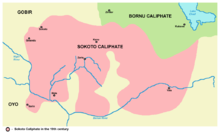Hausa Kingdoms

| Part of a series on the | ||||||||||||
| History of Nigeria | ||||||||||||
|---|---|---|---|---|---|---|---|---|---|---|---|---|
 | ||||||||||||
| Timeline | ||||||||||||
|
||||||||||||
| Topics | ||||||||||||
| By state | ||||||||||||
| See also | ||||||||||||
|
| ||||||||||||
Hausa Kingdoms, also known as Hausa Kingdom or Hausaland,[1] was a collection of states started by the Hausa people, situated between the Niger River and Lake Chad (modern day northern Nigeria). Hausaland lay between the Western Sudanic kingdoms of Ancient Ghana, Mali and Songhai and the Eastern Sudanic kingdoms of Kanem-Bornu. Hausaland took shape as a political and cultural region during the first millennium CE as a result of the westward expansion of Hausa peoples. They arrived to Hausaland when the terrain was converting from woodlands to savannah. They started cultivating grains, which led to a denser peasant population. They had a common language, laws and customs. The Hausa were known for fishing, hunting, agriculture, salt-mining, and blacksmithing.
By the 14th century,
Though the 7 Hausa states shared the same lineage, language and culture, the states were characterized by fierce rivalries with each other with each state seeking supremacy over the others. They constantly waged war on each other and would often work with invaders to the detriment of their sister states, hindering their collective strength.[2]
Mythology
According to the
Hausa Bakwai
The Hausa Kingdoms began as seven states founded according to the
Since the beginning of Hausa history, the seven states of Hausaland divided up production and labor activities in accordance with their location and natural resources. Kano and Rano were known as the "Chiefs of Indigo." Cotton grew readily in the great plains of these states, and they became the primary producers of cloth, weaving and dying it before sending it off in caravans to the other states within Hausaland and to extensive regions beyond. Biram was the original seat of government, while Zaria supplied labor and was known as the "Chief of Slaves." Katsina and Daura were the "Chiefs of the Market," as their geographical location accorded them direct access to the caravans coming across the desert from the north. Gobir, located in the west, was the "Chief of War" and was mainly responsible for protecting the empire from the invasive Kingdoms of Ghana and Songhai.
Hausa Bastard/ Banza/ Illegitimate States

According to the
- Zamfara (state inhabited by Hausa-speakers)
- Kebbi(state inhabited by Hausa-speakers)
- Yauri (also called Yawuri)
- Gwari(also called Gwariland)
- Kwararafa (the state of the Jukun people)
- Nupe(state of the Nupe people)
History
Zenith
The Hausa Kingdoms were first mentioned by
Fall

Despite relatively constant growth from the 15th century to the 18th century, the states were vulnerable to constant war internally and externally. By the 18th century, they were economically and politically exhausted.
References
- ISBN 978-0-521-51430-9.
- ^ Palmer, III, 132-4; Smith, Daura, 52-55
- ^ Hogben/Kirk-Greene, Emirates, 82-88; Lange, Kingdoms, 216-221, 554 n. 25.
- ^ Smith, Daura, 419-421.
Further reading
- Hogben, S. J.; Kirk-Greene, Anthony (1966). The Emirates of Northern Nigeria. London. pp. 145–155.
{{cite book}}: CS1 maint: location missing publisher (link) - ISBN 978-0-521-51430-9.
- Nicolas, Guy (1975). Dynamique sociale et appréhension du monde au sein d'une société hausa. Paris.
{{cite book}}: CS1 maint: location missing publisher (link) - Palmer, Herbert R. (1928). "Bayajidda legend". Sudanese Memoirs. Vol. 3. Lagos. pp. 132–146.
{{cite book}}: CS1 maint: location missing publisher (link) - Smith, Michael (1978). The Affairs of Daura. Berkeley.
{{cite book}}: CS1 maint: location missing publisher (link)
